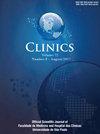甘草查尔酮A通过调节TLR4/NF-κB信号通路对胶质瘤细胞增殖、侵袭及耐药的影响
IF 2.4
4区 医学
Q2 MEDICINE, GENERAL & INTERNAL
引用次数: 0
摘要
目的:基于Toll样受体4 (TLR4)/核因子-κB (NF-κB),探讨Licochalcone A (LCA)通过信号通路对胶质瘤细胞增殖、侵袭及耐药的影响。方法:体外培养人胶质瘤细胞株U251,用替莫唑胺(TMZ)诱导耐药细胞株U251/TMZ,并对结果进行验证。采用不同浓度甘草查尔酮A处理U251细胞和U251/TMZ细胞,分别命名为对照组、低剂量组、中剂量组和高剂量组。采用CCK-8法、细胞粘附法和Transwell法分别检测细胞存活率、细胞粘附率、迁移细胞数和侵袭细胞数。结果:高剂量组细胞存活率、细胞黏附率、迁移细胞数和侵袭细胞数均低于中剂量组,低于对照组。高剂量组大鼠TLR4、NF-κB mRNA及蛋白水平均低于中剂量组,低于对照组(p < 0.05)。与si-NC组比较,si-TLR4组细胞存活率和粘附率降低,迁移和侵袭细胞数量减少,CyclinD1和N-cadherin蛋白水平降低,E-cadherin蛋白水平升高(p < 0.05)。结论:LCA可能通过抑制TLR4/NF-κB信号通路,抑制胶质瘤细胞增殖转移,逆转耐药。本文章由计算机程序翻译,如有差异,请以英文原文为准。
The effect of Licochalcone A on proliferation, invasion, and drug resistance of glioma cells by regulating TLR4/NF-κB signaling pathway
Objective
Based on Toll Like Receptor 4 (TLR4)/Nuclear Factor-κB (NF-κB) Exploring the effects of Licochalcone A (LCA) on the proliferation, invasion, and drug resistance of glioma cells through signaling pathways.
Methods
Cultivate human glioma cell line U251 in vitro, induce drug-resistant cell line U251/TMZ with Temozolomide (TMZ), and validate the results. Different concentrations of licorice chalcone A were used to treat U251 cells and U251/TMZ cells, and were named as control group, low-dose group, medium-dose group, and high-dose group, respectively. CCK-8 assay, cell adhesion assay, and Transwell assay were used to detect cell survival rate, cell adhesion rate, number of migrating cells, and number of invading cells, respectively.
Results
The cell survival rate, cell adhesion rate, number of migrating and invading cells in the high-dose group were lower than those in the medium-dose group and lower than those in the control group. High-dose group TLR4, NF-κB mRNA and protein levels were lower than those in the medium dose group and lower than those in the control group (p < 0.05). Compared with the si-NC group, the si-TLR4 group showed a decrease in cell survival rate and adhesion rate, as well as a decrease in the number of migrating and invading cells, the levels of CyclinD1 and N-cadherin proteins decreased, while the levels of E-cadherin protein increased (p < 0.05).
Conclusion
LCA could inhibit the proliferation and metastasis of glioma cells and reverse drug resistance, possibly by inhibiting the TLR4/NF-κB signaling pathway.
求助全文
通过发布文献求助,成功后即可免费获取论文全文。
去求助
来源期刊

Clinics
医学-医学:内科
CiteScore
4.10
自引率
3.70%
发文量
129
审稿时长
52 days
期刊介绍:
CLINICS is an electronic journal that publishes peer-reviewed articles in continuous flow, of interest to clinicians and researchers in the medical sciences. CLINICS complies with the policies of funding agencies which request or require deposition of the published articles that they fund into publicly available databases. CLINICS supports the position of the International Committee of Medical Journal Editors (ICMJE) on trial registration.
 求助内容:
求助内容: 应助结果提醒方式:
应助结果提醒方式:


